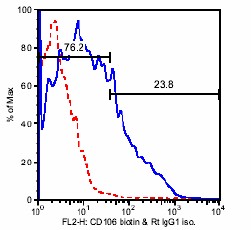Vcam1 Rat Monoclonal Antibody [Clone ID: M/K-2]
Specifications
| Product Data | |
| Clone Name | M/K-2 |
| Applications | FC |
| Recommended Dilution | Flow Cytometry. The clone is also reported to work with Frozen Sections. |
| Reactivities | Mouse |
| Host | Rat |
| Isotype | IgG1 |
| Clonality | Monoclonal |
| Specificity | This anti-Mouse CD106 (VCAM-1) monoclonal antibody recognizes an antigen that is constitutively expressed on bone marrow stromal cells and myeloid cells, and its expression on endothelial cells is upregulated by inflammatory cytokines and in certain pathologic conditions. Result for Tissue Distribution by Flow Cytometry Analysis Mouse Strain: C57BL/6 Cell Concentration: 1x10e6 cells per test. Antibody Concentration Used: 0.25 µg/10e6 cells. Isotypic Control: Biotin Rat IgG1. |
| Formulation | PBS, containing 0.09% Sodium Azide and EIA grade BSA as a stabilizing protein to bring total protein concentration to 4-5 mg/ml Label: Biotin State: Liquid purified Ig fraction. |
| Concentration | 0.1 mg/ml |
| Conjugation | Biotin |
| Gene Name | vascular cell adhesion molecule 1 |
| Database Link | |
| Background | VCAM1 is important in cell-cell recognition. Appears to function in leukocyte-endothelial cell adhesion. Interacts with the integrins alpha4 beta1 (beta 1 integrin VLA4) and alpha4 beta7 on leukocytes, and mediates both adhesion and signal transduction. The VCAM1/VLA4 interaction may play a pathophysiologic role both in immune responses and in leukocyte emigration to sites of inflammation. VCAM1 is also expressed by several non endothelial cell types including some macrophages, follicular dendritic cells and bone marrow, stromal cells. VCAM-1 is a counter-receptor for VLA-4 (α4β1 integrin) and LPAM-1 (α4β7 integrin). |
| Synonyms | V-CAM 1, INCAM-100, L1CAM, VCAM-1 |
| Note | Protocol: Flow Cytometry Analysis: Method: 1. Prepare a cell suspension in media A. For cell preparations, deplete the red blood cell population with cell separation medium. 2. Wash 2 times. 3. Resuspend the cells to a concentration of 2x10e7 cells/ml in media A. Add 50 µl of this suspension to each tube (each tube will then contain 1 x 10e6 cells, representing 1 test). 4. To each tube, add ~1.0 µg* of SM051B per 1 x 10e6 cells. 5. Vortex the tubes to ensure thorough mixing of antibody and cells. 6. Incubate the tubes for 30 minutes at 4°C. 7. Wash 2 times at 4°C. 8. Add 100 µl of secondary antibody (Streptavidin-PE) at a dilution suggested by the supplier. 9. Incubate tubes at 4°C for 30 - 60 minutes (It is recommended that tubes are protected from light since most fluorochromes are light sensitive). 10. Wash 2 times at 4°C. 11. Resuspend the cell pellet in 50 µl ice cold media B. 12. Transfer to suitable tubes for flow cytometric analysis containing 15 µl of propidium iodide at 0.5 mg/ml in PBS. This stains dead cells by intercalating in DNA. Media: A. Phosphate buffered saline (pH 7.2) + 5% normal serum of host species + sodium azide (100 µl of 2M sodium azide in 100 mls). B. Phosphate buffered saline (pH 7.2) + 0.5% Bovine serum albumin + sodium azide (100 µl of 2M sodium azide in 100 mls). * Appropriate control samples should always be included in any labelling studies |
| Reference Data | |
Documents
| Product Manuals |
| FAQs |
| SDS |
{0} Product Review(s)
0 Product Review(s)
Submit review
Be the first one to submit a review
Product Citations
*Delivery time may vary from web posted schedule. Occasional delays may occur due to unforeseen
complexities in the preparation of your product. International customers may expect an additional 1-2 weeks
in shipping.






























































































































































































































































 Germany
Germany
 Japan
Japan
 United Kingdom
United Kingdom
 China
China



